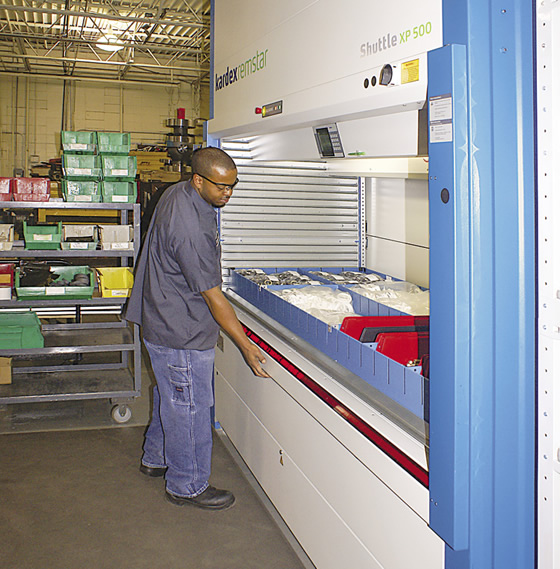END USER: Cameron, (713) 513-3300, www.c-a-m.com.
CHALLENGE: Improve inventory control and consolidate hundreds of cabinets and drawers for storing tooling and gages.
SOLUTION: An automated storage system integrated with inventory management software.
SOLUTION PROVIDER: Kardex Remstar, (800) 639-5805, www.kardexremstar.com.
Valves are a critical component for the oil and gas industry. The Valves & Measurement group of Houston-headquartered Cameron should know: The group’s facility in Oklahoma City, Okla., manufactures—to stringent standards—800,000 valves a year to control and direct the flow of oil and gas through many different channels.
Because of the high production volume, managing and locating the CNC tooling, gages and components required to make valves can be overwhelming. “Tools were being stored in cabinets and drawers, but it wasn’t very organized,” said Bobby Maxwell, the group’s senior tool and die maker. “It slows production when you can’t find the right tool.”
Hundreds of storage cabinets with drawers for tooling and gages were spread throughout the facility. Operators didn’t keep any records of who, where, why or when they were used, resulting in lost equipment and excess inventory. In addition, the storage areas were not secure and inventory was extremely unorganized, according to Maxwell.
With demand for its valves on the rise, the company knew it needed to improve inventory control to boost productivity. To consolidate inventory storage, Cameron purchased two Shuttle XP vertical lift modules (VLM) from Kardex Remstar, Westbrook, Maine. One automated VLM is 12 ' (3.6m) tall and the other is 19 ' (5.8m) tall and they store all the tools and gages previously held in individual cabinets. Both are integrated with inventory management software.
Before the process was automated, operators would walk through the facility and search drawers for the tools and gages they needed. On average, an operator would spend 34 minutes each day picking through drawers and an additional 48 minutes per week hunting for misplaced items. When an item couldn’t be found, a new one was added to inventory.

The Kardex Remstar Shuttle XP VLM system at Cameron saves operators from searching through cabinets spread throughout its facility for the needed tools and gages for a job.
With the automated system, operators walk to one central zone for tooling and one for gages. With the push of a button, an extractor that runs up and down the middle of a VLM brings the tray with the necessary tools to the operator at an ergonomic workstation. Gathering the tools and gages now takes 5 minutes, reducing the time spent searching for them by 42 hours annually and increasing productivity by about 86 percent in both zones.
Because access to tools and gages was available to anyone, inventory was frequently lost or damaged without accountability. This changed when the VLM system’s inventory management software began tracking the location of tools and gages. “The VLM in the gage lab is in a controlled office, and users need a password to access the VLM,” said Arthur Wathan, quality inspector. Once an operator has access, he can store and retrieve inventory, and the software records each transaction.
Under the old system, uncontrolled inventory was a safety risk and tooling could be damaged, according to Maxwell. With the automated approach, a safety light curtain is located in the access opening of a VLM. If the light barrier is broken while the VLM is in motion, it will stop to protect employees from injury. In addition, products are stored in a clean and organized environment to maintain their integrity.
After the successful implementation of the VLMs for storing tooling and gages, the components zone consolidated its inventory into one 12 '-tall Shuttle VLM. This reduced the allocated floor space for components from 294 to 91 sq. ft. (89.6 to 27.7 sq. m)—a 69 percent reduction. “Space is always a constraint in our facility,” said Jose Alca, manufacturing engineer II. “Freeing up floor space allows other processes around the VLM to become more efficient.”
In addition, under the old system, misplaced items in the components zone cost Cameron $83,000 in inventory per year. Because the VLM requires inventory cycle counting, Cameron reduced misplaced inventory by 70 percent, saving $58,000 annually.
Related Glossary Terms
- computer numerical control ( CNC)
computer numerical control ( CNC)
Microprocessor-based controller dedicated to a machine tool that permits the creation or modification of parts. Programmed numerical control activates the machine’s servos and spindle drives and controls the various machining operations. See DNC, direct numerical control; NC, numerical control.








